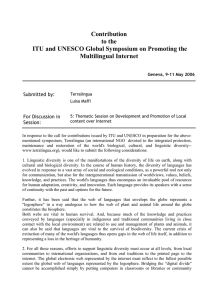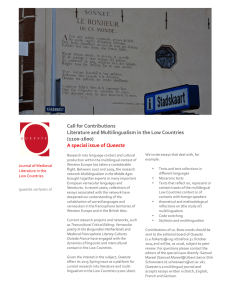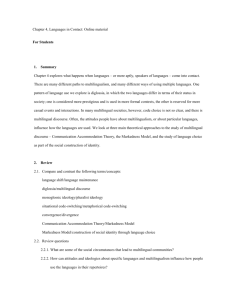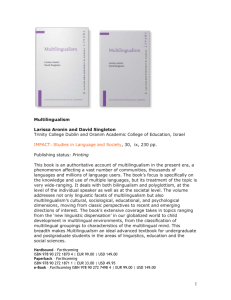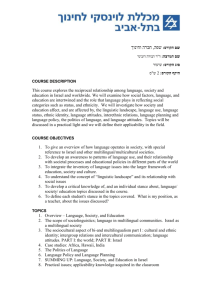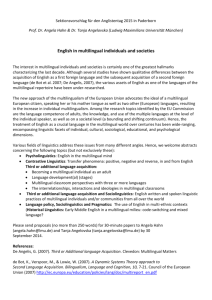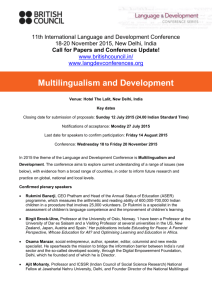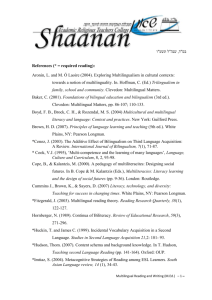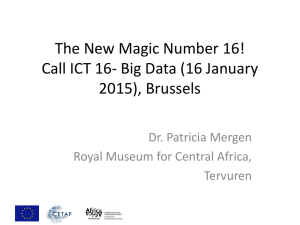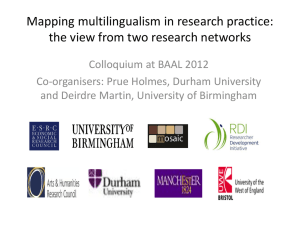MULTILINGUALISM IN THE CLASSROOM
advertisement
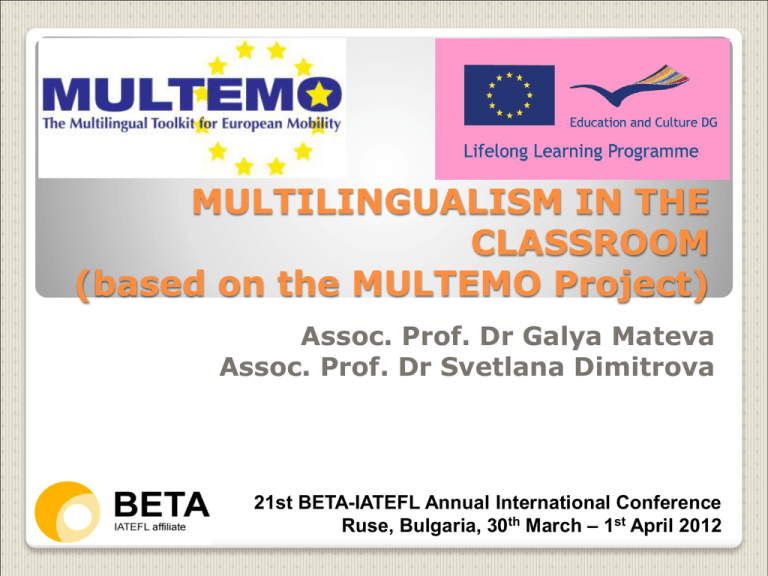
MULTILINGUALISM IN THE CLASSROOM (based on the MULTEMO Project) Assoc. Prof. Dr Galya Mateva Assoc. Prof. Dr Svetlana Dimitrova 21st BETA-IATEFL Annual International Conference Ruse, Bulgaria, 30th March – 1st April 2012 Video: How to become fluent in 11 languages – multilingualism in practice 20 year old Alex Rawlings explains how he became fluent in 11 languages: “The more [languages] you learn, the easier it becomes.” Aangenaam u te ontmoeten! Mucho gusto en conocerle!~Encantado/-da! Malonu susipazinti! Angenehm! Incantant de cunostinta! Je suis très heureuxse de faire votre connaissance! ~ Enchanté/-e. Mi fa molto piacere conoscerla.~ Tanto piacere! Очень рада с Вами познакомиться! What is the English equivalent? How many (groups of) languages did you recognise? How did you decide? HOW TO INTERPRET MULTILINGUALISM? 6000-7000 languages in existence in the world (half of them dying out) 700 languages in a single country 19 official languages in a country City schools with 30 mother tongues among students Countries where English is spoken as L1 or L2 Countries with majority / minority languages Monolingual countries with less widely spoken languages DIFFERENT CONTEXTS, DIFFERENT INTERPRETATIONS Smooth transition from L1 to L2, L3? Learning one`s mother tongue, one regional or official language and one international language? Integrating knowledge of several languages in foreign language classes? Can these be considered multilingual education? What is the difference in approach? SUCCESSIVE OR SIMULTANEOUS MULTILINGUALISM? OR MAYBE BOTH? The project context Experimenting with aspects of simultaneous multilingualism in European schools where English is L1 or L2 and where classes are predominantly monolingual Integrated into the L2 syllabus basic knowledge, comprehension skills and partial use of multiple languages determined by the needs of cultural and linguistic diversity, globalisation and transnational mobility. DEFINING MULTILINGUALISM IN THE PRESENT CONTEXT BACKGROUND TO THE ORIGINAL IDEATHE LANGUAGES BRIDGE AND THE MULTEMO PROJECT The Languages Bridge© A multilingual approach to acquiring language learning strategies and knowledge about language Currently used in over 100 primary and secondary schools in the UK [age range 8-13] www.ilrc.co.uk I L R C THE INTERNATIONAL LEARNING AND RESEARCH CENTRE IN BATH The Languages Bridge© Rationale for the project • By drawing on a number of different languages, the multilingual approach can be very successful in improving pupils’ general language learning ability. • The Building Blocks support generic language learning aptitude, they do not teach a specific language. I L R C THE INTERNATIONAL LEARNING AND RESEARCH CENTRE IN BATH The Languages Bridge© Which languages are included? French Spanish Portuguese I L R C German Italian Mandarin Romanian Japanese THE INTERNATIONAL LEARNING AND RESEARCH CENTRE IN BATH THE INTERNATIONAL RESEARCH BB4 - Word properties BB2 - Sound andAND word recognition BB5 - Sentence types IN BATH LEARNING CENTRE I L R BB1- General sound discrimination C BB3 - Word classes BB6 - Real purposes & real audiences A Leonardo EU project aiming to adapt the Languages Bridge Methodology to Vocational Contexts (2010-2012) Coordinator: ILRC, Bath THE MULTEMO PROJECT PARTNERS: UK, Germany, Holland, Lithuania & OPTIMA, Bulgaria BY COMPARING AND ANALYSING ASPECTS OF DIFFERENT LANGUAGES IN PROFESSIONAL CONTEXTS : To develop generic language knowledge and language learning skills To develop basic metalinguistic awareness across languages and language groups To contribute to learners` multicultural competence in an increasingly global and competitive world To contribute to the development of learners` thinking skills To contribute to the development of learners` social and general communication skills MULTEMO AIMS CONTRASTIVE ANALYSIS COOPERATIVE LEARNING THINKING/REFLECTIVE SKILLS THE THREE PILLARS OF THE MULTILINGUAL APPROACH Contrastive analysis can be defined as an inductive, investigative approach based on the distinctive elements in one or more languages. It consists of: ◦ Type A “Intralingual” ◦ Type B “Crosslinguistic” Type B includes comparative analysis of phonological, morphological, syntactic, lexical, semantic, discourse features, as well as study of interference of languages THE FIRST PILLAR: CROSSLINGUISTIC ASPECTS OF CONTRASTIVE ANALYSIS AVVOCATO A V OCAT A B OGADO ADVOCATE АДВОКАТ Italian French Spanish English български и руски Try to notice the different letters and the consonant changes. CROSSLINGUSTIC ANALYSISNOTICING AND REFLECTING Features of language cannot be learned unless they have been noticed (after R. Schmidt). Noticing can be regarded as a bridge connecting the subconscious and conscious mind in the process of learning. Noticing should be followed by analysis. The analysis involves various thinking processes. Active thinking is fostered by group interaction. CROSSLINGUSTIC ANALYSISNOTICING AND REFLECTING Excuse me, where is the exit? Pardon, waar is de uitgang? Scusi, dove e la uscita? Entschuldigung! Wo ist der Ausgang? Atsiprasau, kur yra isejimas? Простите, где выход? Извинете, къде е изходът? Perdone, donde esta la salida? CROSSLINGUISTIC ANALYSIS Which are the languages/language groups? Linguistic features Language Group1 Language Group 1 Language Group 2 Language Group 2 Language Group 3 Language Group 3 Language Group 4 Language Dutch German Italian Spanish Bulgarian Russian Lithuanian noun EXIT article THE Question word WHERE Verb IS Polite address EXCUSE ME CROSSLINGUISTIC ANALYSIS CONTRASTING LINGUISTIC FEATURES Step 1: Work in groups of four and decide together on the language groups and languages exemplified. Step 2: Work individually to complete the language group of your choice. Step 3: Work again in your group of four, look at your team findings and discuss all languages: ◦ ◦ ◦ ◦ ◦ Similarities/differences Similarities/differences Similarities/differences Similarities/differences Similarities/differences in in in in in the the the the the noun article question word verb polite address Step 4: What did you find out about languages? What strategies did you apply? Step 5: Reflect on your performance, on the group interaction and the contributions of all participants. How successful were you? Don`t forget to praise each other! Learning in small groups where interaction is STRUCTURED according to a set of PRINCIPLES 1.Simultaneous interaction 2.Equal participation 3.Positive interdependence 4.Individual accountability (after Jette Stenlev, 2003) THE SECOND PILLAR: COOPERATIVE LEARNING The STRUCTURE (precise step-by-step guidance of interaction) and the assigned individual roles distinguish cooperative learning from traditional group work. Different aims require different structures which guide group interaction Crosslinguistic analysis develops learners` knowledge, communication, thinking and social skills Each structured group interaction ends with reflective THINKING COOPERATIVE LEARNING AND MULTILINGUAL TASKS LOTS low order thinking skills Identifying structures, spelling rules Remembering chunks of language Classifying letters into aliens, traitors and friends Locating the position of articles, suffixes HOTS high order thinking skills Contrasting parts of speech, word order Making associations with L1, with existing schemata Reasoning and answering WHY questions Evaluating and reflecting on one`s own performance at the end of a task THE THIRD PILLAR:THINKING SKILLS AND MULTILINGUAL TASKS Personal awareness of acquired multilingual knowledge Personal awareness of applied cognitive strategies Personal consideration of one`s own learning Personal consideration of achievement Personal consideration of the benefit of group interaction REFLECTIVE THINKING ON PROCESSES AND MULTILINGUAL TASK OUTCOMES MULTILINGUAL TASK TYPOLOGY Defining MULTEMO tasks A task is an activity “where the target language is used by the learner for a communicative purpose (goal) in order to achieve an outcome”. (Jane Willis 2005) The Multilingual tasks are content-based & theme-based, the procedure often involves reflection & problem solving, the outcome of the task is related to improved generic language competence and enhanced language learning skills. Task design is tailored in accordance with: vocational contexts [the need to use the language in professional situations] the age range of target student groups [secondary school, 13+] the level of FL competence & the linguistic experience of the students MULTEMO TASK TYPOLOGY the impact of the target learners Need analysis of target student groups in vocational contexts revealed a consistent trend (across partner countries / educational institutions) for predominant use of foreign languages by students: when travelling abroad; when communicating with foreign friends and business partners; when browsing the internet for study - or work-related resources & materials in other languages. MULTEMO TASK TYPOLOGY the choice of topics and tasks verbal [authentic or adapted] (e.g. sound files with words/phrases, dialogues, songs, quizzes, story extracts, newspaper and magazine articles or advertisements, letters or emails, post cards or business cards, hotel or travel brochures, menus, weather forecasts, diaries, TV / seminar programmes, timetables, etc.) non-verbal (e.g. a picture set or sequence, photographs, video clips, graphs and charts, some realia – e.g. menus with illustrating photos, pictures of airport signs and display boards, computer screen shots, etc.) Parallel in several languages MULTEMO TASK TYPOLOGY the input TASK TYPES Listing Ordering & sorting - brainstorming - fact-finding - sequencing - classifying/categorizing Problem solving Comparing & matching - analysing - reasoning - decision making - finding differences - finding similarities Sharing personal expereinces - narrating - describing - exploring & explaining MULTEMO TASK TYPOLOGY Language form focus • PHONOLOGY: sound discrimination • GRAPHEMOLOGY: discrimination of the letters of the Cyrillic alphabet, recognition of language families and typical characteristics of languages • MORPHOLOGY: recognition and manipulation of word classes, understanding of word structure (prefixes, suffixes) and its impact on the general word meaning, understanding of grammatical / semantic categories such as gender, number or tense and their exponents in languages (e.g. tense markers, determiners, etc.) • SYNTAX: understanding of sentence types (e.g. questions, negatives, imperatives) and construction (word order) • LEXICOLOGY: recognition and comprehension of international words and cognates • DISCOURSE/TEXT: recognition and manipulation of text types MULTEMO TASK TYPOLOGY Skills or language-in-use focus • Developing the receptive skills (READING & LISTENING comprehension): context reliance in the interpretation of meaning, using prosodic features (intonation) and supralingual elements of speech (body language) to aid comprehension, using reference materials (incl. online ones) to help language learning • Developing the productive skills (SPEAKING & WRITING): understanding and executing language functions & communicative tasks – e.g. introductions, thanking, expressing opinion, (dis)agreeing, making requests, telephoning, ordering food, effective use of computer language, etc. • Developing intercultural competence: understanding and manipulating degrees of politeness, non-verbal patterns of behaviour , etc. MULTEMO TASK TYPOLOGY BENEFITS AND OUTCOMES OF SIMULTANEOUS MULTILINGUAL EDUCATION TO HAVE ANOTHER LANGUAGE IS TO POSSESS ANOTHER SOUL king of France, 8th century GIVEN THE APPROPRIATE ENVIRONMENT TWO LANGUAGES ARE AS NORMAL AS TWO LUNGS V.COOK, 2002 Perception and analysis of multiple linguistic features General language learning skills and strategies Cognitive flexibility and higher-order thinking skills of learners Confidence in situations of real-life vocational communication Employment advantages and social adaptability of learners Ability to expand horizons and appreciate other and own culture from a different perspective BENEFITS AND OUTCOMES OF SIMULTANEOUS MULTILINGUALISM: WHAT CAN BE IMPROVED? KOSZONOM A FIGYELMUKET!
